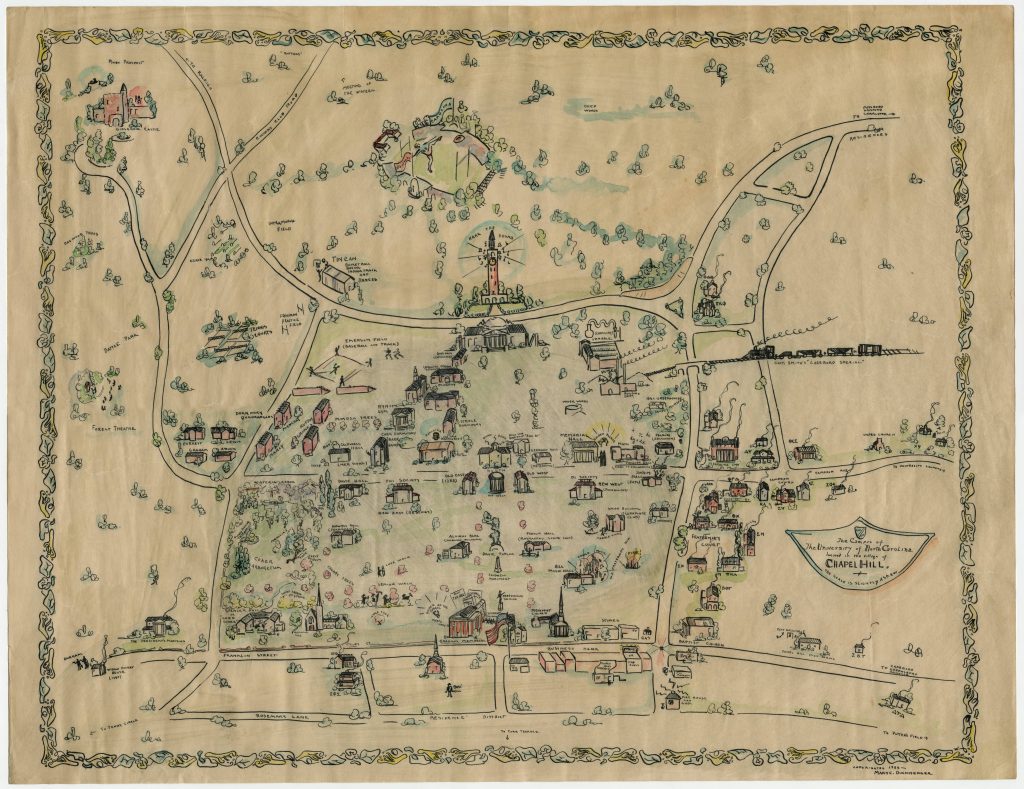
Dirnberger, Mary C. “The Campus of The University of North Carolina, Located in the Village of Chapel Hill.” Map. In Southern Historical Collection, Wilson Library, University of North Carolina at Chapel Hill. 1933. Accessed November 5, 2018. https://dc.lib.unc.edu/cdm/singleitem/collection/ncmaps/id/3440/rec/6.
The artifact that I have found comes from the North Carolina Maps database. The particular map that I have selected displays the many buildings in and around the University of North Carolina at Chapel Hill. This map specifically displays school buildings, stores, churches, and fraternity houses.[1]This map depicts 23 of the 28 officially recognized fraternities that had been chartered up until 1933, the year this map was drawn.[2]Each of these 23 houses is denoted using their Greek letters. These houses are important on this map because prohibition impacted the social scene at the University of North Carolina.
This map was drawn right around the end of prohibition which proves to be an interesting topic when it comes to social life on a college campus. There are a few important perspectives to consider when looking at the social atmosphere. In 1931-32, J. H. Barnett studied the attitude of seniors towards the 18thamendment. Of the 3,250 seniors, 2,467 of them were either in favor of part or full repeal of the 18thamendment.[3]The next perspective was that of the people enforcing the law. Bob Payne explains that “efforts to kill the bootlegging business in and around Chapel Hill are about as efficacious as an attempt to empty a well with a sieve.”[4]The last perspective is of that of campus administrators who had begun to recognize these organizations as student organizations roughly thirty years prior to the beginning of prohibition.[5]
Prior to prohibition, students drank freely at their fraternity houses. Not much changed when prohibition started except that “Many students — particularly members of fraternities — had to find ways around Prohibition.”[6]The experience of drinking alcohol in the public eye had turned from an activity that was public and accessible to one of secret and unlawfulness. This is an important story to tell because prohibition created new black markets for alcohol as well as the need to safely hide away large quantities so that if a fraternity was raided, they would not have their whole supply robbed from them. Even when made illegal, alcoholic beverages were a central part of the college diet.
[1]Dirnberger, Mary C. “The Campus of The University of North Carolina, Located in the Village of Chapel Hill.” Map. In Southern Historical Collection, Wilson Library, University of North Carolina at Chapel Hill. 1933. Accessed November 5, 2018. https://dc.lib.unc.edu/cdm/singleitem/collection/ncmaps/id/3440/rec/6.
[2]“History of UNC Fraternities and Sororities.” Carolina Union. Accessed November 5, 2018. https://carolinaunion.unc.edu/departments/fraternity-sorority-life/history-unc-fraternities-and-sororities.
[3]Barnett, J.H. “College Seniors and the Liquor Problem.” The ANNALS of the American Academy of Political and Social Science 163, no. 1 (September 1932): 130–46. http://journals.sagepub.com/doi/pdf/10.1177/000271623216300114.
[4]Holder, Glenn P. “Prohibition on the College Campus.” The Daily Tar Heel (Chapel Hill), September 22, 1929. Accessed November 3, 2018. https://universityofnorthcarolinaatchapelhill.newspapers.com/image/67924934/?terms=Prohibition.
[5]“History of UNC Fraternities and Sororities.”
[6]Beberman, Mallory. “A True Divide: A Look Back at Campus during the Prohibition Era.” The Michigan Daily, November 2, 2010. Accessed November 5, 2018. https://www.michigandaily.com/content/prohibition-era-ann-arbor.